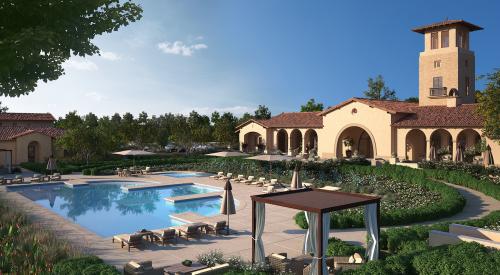There’s a multitude of reasons builders are increasing the percentage of houses they start as specs today, but none of them look good in the face of declining traffic in model homes and the growing likelihood of at least a temporary slump in fall sales.
So far, there’s no statistical data to support our suspicion that home sales are dropping. That’s because the latest hard data, at press time, runs only through the end of July. But when we called builders across the country, the vast majority reported traffic in the models down 10% to 15% over the past six weeks. That’s during a stretch when many markets historically show an increase (following the usual late summer lull).
The unprecedented housing boom now churning toward its ninth year makes it conceivable that many of our readers just don’t realize how dangerous spec inventory can be at a time like this. Let’s correct that deficiency.
"Builders would rather be a little high on specs than miss a sale," says Michigan-based management consultant Michael Anleitner. "But a small builder who does only ten to 15 houses a year is really at risk if two or three specs reach completion without selling. A completed house is an enticing piece of collateral to a lender, and a lot of those guys have signed personal guarantees on their loans. Their whole credit line may be in jeopardy."
Now project that risk over a whole housing market like gargantuan Atlanta, where hundreds of small builders dominate a market that has become accustomed to more than 30,000 single family home sales a year, and more than 60% of houses are started as specs. Obviously, it would not take much of a sales slump to tip that market rapidly toward a dangerous oversupply of spec inventory. That’s what we fear may be happening.
"There’s a whole lot of spec houses out there," says Atlanta move-up giant John Wieland, "and inventories of unsold homes seem to be growing."
Traffic is way down, says Morrison Homes vice president of sales and marketing John Rymer. "The market really hasn’t been good in Atlanta since April," he says. "Across the country, we’re probably starting 10% more houses this year as specs, but we’re still selling most of them by drywall stage, except in Atlanta. We’re not starting anything there until we sell through what we’ve got."
Dick Hearin, executive vice president of Northside Realty, heads the builder/developer services division of the big Atlanta Realtor. He confirms there is a slowdown in traffic and sales, and a build-up in spec inventory:
"What’s different here is that most Atlanta move-ups like to buy spec homes, so they can get into a house quickly and don’t have to deal with a double move. Add to that the high percentage of relocation buyers in a big corporate transferee market and it’s easy to see why we lead the nation in percentage of spec starts. It’s been as high as 70% spec.
"Our traffic is now down 10% to 15%, but contracts are only off 2% to 3%. But we do have an easy credit market, and a lot of new, nontraditional lenders are making loans to too many marginal builders just to get a toehold in the market."
And while the sales slowdown is just beginning, increases in spec building are epidemic. Why?
"Lots of reasons," says Melbourne, Fla.-based Mercedes Homes vice president of operations Scott Buescher, who admits doing more spec starts than ever before. "Our build times have eroded due to labor shortages. Customers don’t like it when you sell them a house and can’t deliver it in the time they expect. By starting houses as specs, we get a head start toward completion.
"People don’t want to wait for anything today," says Buescher. "They buy computers and cars over the Internet, right now. And there’s another problem when you build to suit. Those people go out to the site every day and bug the super. It’s just a lot easier to build spec houses."
Buescher says Mercedes now starts between 30% and 40% of its houses as specs, in divisions across Florida and in Dallas, Texas, and Charlotte, N.C. Mercedes closed 1890 units last year for $256 million. The specs are way up for a company that used to start virtually none.
"Three years ago, we never did specs. Two years ago, we started allowing our division presidents eight specs under construction per division," says Buescher. "If they sold all their models and leased them back, we’d let them have 12 specs. Today, practically all our divisions have between 16 and 20.
"Nobody wants to get caught with unsold inventory as the market softens, but we’ve been using spec starts as a way to regularize our production toward more of an even flow. It’s also easier to get building permits from the municipalities on specs, and we all want to increase our numbers for year-end."
Bingo. That last one hits home, especially for the big, public home builders. "They’ve all got big bonuses hanging in front of managers up and down the organization chart," says Charlotte-based consultant Chuck Graham. "By this time of year, the division presidents are desperately trying to make end of quarter and end of year bonus numbers. Of course they’ll start more specs in the fall.
"Charlotte is historically about a 50% spec start market, across the board, at all price points. While I understand that for the higher priced homes that go mostly to relo buyers, I don’t understand the logic of it at the entry level. Those buyers are in rental apartments. They can wait to move. What do you gain by building spec in that market segment?
"NVR has just issued an edict prohibiting specs in entry-level houses," says Graham. "This is no time to be hanging out there with a lot of spec inventory. Right now, Charlotte is down 20% in building permits and lot sales for the first six months of this year. Closings have not dropped off yet, but I expect we’ll see that when we get the numbers for the third quarter."
Colorado management consultant Chuck Shinn, who works with builders all over the country, sees the disturbing signs of apathy toward the risk associated with specs:
"Builders have forgotten what it’s like to get caught with unsold homes and have to carry them through a market downturn," he says.
"From talking to clients, I’d say traffic and sales are both down about 10% in most of the country. The trouble is, most of the guys had such big backlogs for the last two years, they don’t see the problem yet. They’ve been fighting to get their spec inventory back up."
All the recent economic data points toward a soft landing, not a major recession. In fact, what we are seeing now may be no more than a pause caused by the uncertainty associated with a Presidential election year.
"I think that’s it," says Houston builder Randy Birdwell, principal of Emerald Homes, which closed 1111 houses last year for $191.2 million, in Houston, Austin, Dallas, and Phoenix. "We’re down some in traffic and sales, but I think we’re just seeing a typical fall buying season for an election year.
"Houston and Dallas probably start about 50% of houses on spec across the market. We do 40% in Houston, 30% in Austin, and only 10% in Phoenix, where we are primarily an entry-level builder. In Dallas, we’re doing a start-up, so it’s more like 70% there.
"But I wouldn’t say those spec inventories are excessive. They are just building back to where they need to be in strong relo markets, where transferee buyers always want a house in 30 to 60 days. This time last year, we had only 15 finished and unsold houses in the whole company. This year, we have 63 in Houston, in 15 communities."
Mike Rubery, southern division president for The Drees Co., which also builds in Austin, Cincinnati, Cleveland, Raleigh, Charlotte, and Washington, D.C., says he starts 60% of houses as specs in Dallas, which seems high for a company with an average sale price near $250,000.
"We’re starting more specs this year because we’ve been having trouble getting plans through the building departments in local municipalities," he says. "We’re also trying to push inventory to meet our year-end goals," Rubery admits. "Another reason you see builders starting more specs at this time of year is that most of our labor force is Hispanic, and we can look forward to seeing a large percentage of them go back to Mexico for Christmas. Often, we don’t see them again for 30 to 60 days."
All that may be true, but it’s been so long since anyone was tested by a real market slowdown, it’s hard to believe that markets with 50% or more spec starts will not see significant bloodletting if sales really do drop dramatically.











